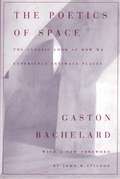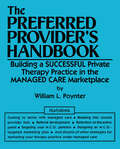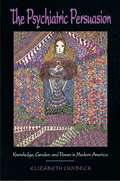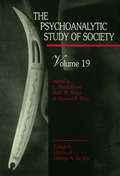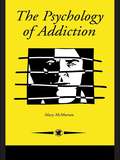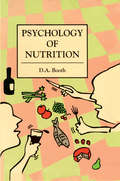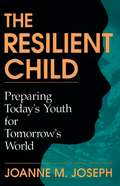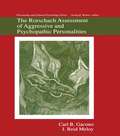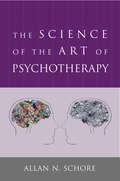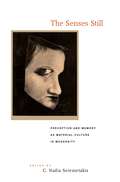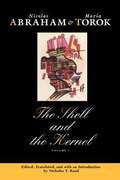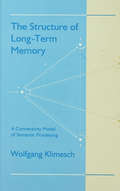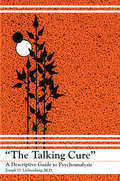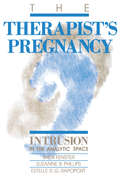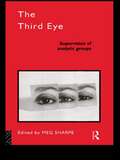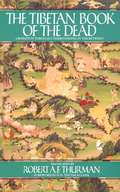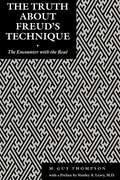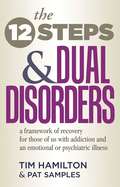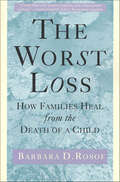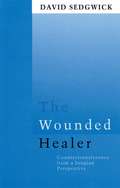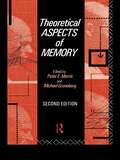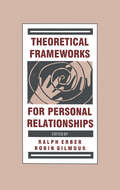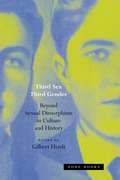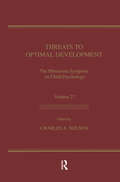- Table View
- List View
The Poetics of Space
by Gaston Bachelard John R. StilgoeThirty years since its first publication in English, French philosopher Gaston Bachelard's The Poetics of Space one of the most appealing and lyrical explorations of home. Bachelard takes us on a journey, from cellar to attic, to show how our perceptions of houses and other shelters shape our thoughts, memories, and dreams.
The Preferred Provider's Handbook: Building A Successful Private Therapy Practice In The Managed Care Marketplace
by William L. PoynterFirst published in 1994. Routledge is an imprint of Taylor & Francis, an informa company.
The Psychiatric Persuasion: Knowledge, Gender, and Power in Modern America
by E. LunbeckIn the years between 1900 and 1930, American psychiatrists transformed their profession from a marginal science focused primarily on the care of the mentally ill into a powerful discipline concerned with analyzing the common difficulties of everyday life. How did psychiatrists effect such a dramatic change in their profession's fortunes and aims? Here, Elizabeth Lunbeck examines how psychiatry grew to take the whole world of human endeavor as its object.
The Psychoanalytic Study of Society, V. 19: Essays in Honor of George A. De Vos
by L. Bryce Boyer Ruth M. Boyer Howard F. SteinCritical appreciations of George A. De Vos, a pioneer in the cross-cultural application of projective techniques (M. Suarez-Orozco, P. Lerner), and De Vos's own reminiscences, are followed by contributions true to the spirit of De Vos's methodology. They include a demonstration of the usefulness of projective tests in the psychodiagnostic evaluation of schizophrenia (J. Stone, P. Wilson & B. Boyer); an examination of the role of historical events in the development of Chinese and Japanese personality characteristics (J. Connor); a review of the impact of Freudian and Jungian thought in India (S. Kakar); and a study of loss and grief in a community of the North American Great Plains (H. Stein).
The Psychology Of Addiction
by Mary McMurranThis text provides a comprehensive overview of psychological approaches to understanding addictions. Without denying the importance of biological Factors, Emphasis Is Placed More Upon Social, Psychological And Emotional factors as is necessary to a complete understanding of addiction. Within this framework, an addiction is not limited to substance-based behaviours such as drinking alcohol, smoking or drug use. Although these important areas are covered, a wider perspective is taken to include behavioural addictions such as gambling, violence and joy riding. Finally, prevention approaches are discussed with reference to the public health model which encompasses issues relating to the agent, the host and the environment. A list of resources and references is provided for those wishing to obtain further information.; Written in a jargon-free style, "The Psychology of Addiction" is aimed at students at the beginning of their courses. It should also be a valuable resource for professionals: nurses, social workers, police and probation officers and medical students, who often encounter the problems described in the book.
The Psychology of Interpersonal Behaviour
by Michael ArgyleThe first edition of this book outlined what amounted to a breakthrough in the analysis of social behaviour. Since then it has become widely used as an introductory textbook of social psychology. It is invaluable to anyone interested in the subject or whose work involves dealing with people, as well as anyone who wants to know how to make friends and influence people. For this new, fifth edition, Michael Argyle includes the latest research on non-verbal communication, social skills and happiness.
The Psychology of Nutrition
by David BoothThis title explores the psychological processes involved in the selection and consumption of foods and drink. The exposition is firmly linked to research evidence on the cognitive, socio-economic and physiological influences on the desire to eat and drink. The basic theory is that appetite is a learned response to a recognized complex of cues from foods, the body and the social and physical environment.; The volume starts with infant-care giver interactions in feeding, then moves on to consider how physical and social maturation in Western culture affects attitudes to foods, concentrating on the phenomena of ordinary dieting and the extremes of disordered eating. The concluding chapters deal with the process within the lives of individual consumers which causes the same eating habits to form in different segments of society. It also looks at food technology, marketing and governmental regulation.; "The Psychology of Nutrition" tackles questions about what goes on in eaters' and drinkers' minds about the foods and beverages they are consuming, and about the cultural meaning of the eating occasion in industrialized cultures.
The Resilient Child: Preparing Today's Youth For Tomorrow's World
by Joanne A. JosephIf you try to identify the basic qualities of a child "most likely to succeed" as an adult, what words might first come to mind? Independent? Likable? Creative? Disciplined? According to Dr. Joanne Joseph, the essence of a productive and healthy personality is a positive and secure self-image and a solid set of resilient attitudes and behaviors. The Resilient Child: Preparing Today's Youth for Tomorrow's World successfully integrates the latest information available about healthy cognitive development, self-esteem, and resilience to give parents and teachers practical suggestions for nurturing these qualities in children and adolescents. Dr. Joseph, an esteemed psychologist and child education consultant, skillfully shows how stories, television, nutrition, exercise, parental discipline style, and the child's individual characteristics each play a comprehensive role in the development of a child's self-esteem and resilience. With the author's clearly outlined strategies, parents and educators can guide children to be socially skillful, responsible, disciplined, good problem-solvers, and effective managers of the change and adversity inherent in today's world. Elaborating beyond what others have identified as the elements of a productive personality, Dr. Joseph uses a series of inspiring anecdotes and documented research to discuss the following: what experts do and do not know about the development of self-esteem; how parents and teachers can actively contribute to the natural development of a child's self-esteem; how to promote resilience in children through happy and difficult times; the kinds of characteristics that differentiate children from each other; how to liberate a child's inner strengths to build self-esteem and resilience; how literature and the media can teach resilient and productive values and behaviors; styles of parental discipline and their influence on the development of the child; and more.
The Rorschach Assessment of Aggressive and Psychopathic Personalities (Personality and Clinical Psychology)
by Carl B. Gacono J. Reid MeloyThis book provides a definitive empirical study of antisocial character pathology and its assessment through the use of the Rorschach. Drawing upon a decade of research with nearly 400 individuals in various hospitals and prisons, the authors paint an extraordinary intrapsychic picture of the personality structure and psychodynamics of these troublesome patients.Serving as both an educational tool and a reference text, this book presents: * Rorschach data on several different antisocial groups -- conduct disordered children and adolescents, antisocial personality disordered adult males with and without schizophrenia, antisocial adult females, and male and female sexual homicide perpetrators; * nomothetic (group) and idiographic (case study) data; * data which have been analyzed and theoretically interpreted using both structural methods and psychoanalytic approaches which represent the cutting edge of Rorschach theory and practice; and* a developmental approach in analyzing Rorschach data gathered from antisocial children, adolescents, and adults -- providing striking similarities. This is the first Rorschach database of this type that has ever been published. As such, it serves as a valuable reference text for Rorschach users -- providing a definitive empirical base, theoretical integration, and a focus on individuals who create severe problems for society.
The Science of the Art of Psychotherapy (Norton Series on Interpersonal Neurobiology)
by Allan N. SchoreThe latest work from a pioneer in the study of the development of the self. Focusing on the hottest topics in psychotherapy--attachment, developmental neuroscience, trauma, the developing brain--this book provides a window into the ideas of one of the best-known writers on these topics. Following Allan Schore's very successful books on affect regulation and dysregulation, also published by Norton, this is the third volume of the trilogy. It offers a representative collection of essential expansions and elaborations of regulation theory, all written since 2005. As in the first two volumes of this series, each chapter represents a further development of the theory at a particular point in time, presented in chronological order. Some of the earlier chapters have been re-edited: those more recent contain a good deal of new material that has not been previously published. The first part of the book, Affect Regulation Therapy and Clinical Neuropsychoanalysis, contains chapters on the art of the craft, offering interpersonal neurobiological models of the change mechanism in the treatment of all patients, but especially in patients with a history of early relational trauma. These chapters contain contributions on "modern attachment theory" and its focus on the essential nonverbal, unconscious affective mechanisms that lie beneath the words of the patient and therapist; on clinical neuropsychoanalytic models of working with relational trauma and pathological dissociation: and on the use of affect regulation therapy (ART) in the emotionally stressful, heightened affective moments of clinical enactments. The chapters in the second part of the book on Developmental Affective Neuroscience and Developmental Neuropsychiatry address the science that underlies regulation theory's clinical models of development and psychopathogenesis. Although most mental health practitioners are actively involved in child, adolescent, and adult psychotherapeutic treatment, a major theme of the latter chapters is that the field now needs to more seriously attend to the problem of early intervention and prevention. Praise for Allan N. Schore: "Allan Schore reveals himself as a polymath, the depth and breadth of whose reading-bringing together neurobiology, developmental neurochemistry, behavioral neurology, evolutionary biology, developmental psychoanalysis, and infant psychiatry-is staggering." -British Journal of Psychiatry "Allan Schore's...work is leading to an integrated evidence-based dynamic theory of human development that will engender a rapproachement between psychiatry and neural sciences."-American Journal of Psychiatry "One cannot over-emphasize the significance of Schore's monumental creative labor...Oliver Sacks' work has made a great deal of difference to neurology, but Schore's is perhaps even more revolutionary and pivotal...His labors are Darwinian in scope and import."-Contemporary Psychoanalysis "Schore's model explicates in exemplary detail the precise mechanisms in which the infant brain might internalize and structuralize the affect-regulating functions of the mother, in circumscribed neural tissues, at specifiable points in it epigenetic history." -Journal of the American Psychoanalytic "Allan Schore has become a heroic figure among many psychotherapists for his massive reviews of neuroscience that center on the patient-therapist relationship." -Daniel Goleman, author of Social Intelligence
The Senses Still: Perception and Memory as Material Culture in Modernity
by C. Nadia SeremetakisWhat has happened to regional experiences that identify and shape culture? Regional foods are disappearing, cultures are dissolving, and homogeneity is spreading. Anthropologist and award-winning author of The Last Word: Women, Death, and Divination in Inner Mani, C. Nadia Seremetakis brings together essays by five scholars concerned with the senses and the anthropology of everyday life. Covering a wide range of topics—from film to food, from nationalism to the evening news—the authors describe ways in which sensory memories have preserved cultures otherwise threatened by urbanism and modernity. <p><p> The contributors are Susan Buck-Morss, Allen Feldman, Jonas Frykman, C. Nadia Seremetakis, and Paul Stoller. <p> C. Nadia Seremetakis is Advisor to the Minister of Public Health in Greece and visiting professor at the National School of Public Heath in Athens. She is the author of The Last Word: Women, Death, and Divination in Inner Mani, available from the University of Chicago Press.
The Shell and the Kernel: Renewals of Psychoanalysis, Volume 1
by Nicolas Abraham Maria Torok Nicholas Rant Nicholas Rand<p>This volume is a superb introduction to the richness and originality of Abraham and Torok's approach to psychoanalysis and their psychoanalytic approach to literature. Abraham and Torok advocate a form of psychoanalysis that insists on the particularity of any individual's life story, the specificity of texts, and the singularity of historical situations. In what is both a critique and an extension of Freud, they develop interpretive strategies with powerful implications for clinicians, literary theorists, feminists, philosophers, and all others interested in the uses and limits of psychoanalysis. <p>Central to their approach is a general theory of psychic concealment, a poetics of hiding. Whether in a clinical setting or a literary text, they search out the unspeakable secret as a symptom of devastating trauma revealed only in linguistic or behavioral encodings. Their view of trauma provides the linchpin for new psychic and linguistic structures such as the "transgenerational phantom," an undisclosed family secret handed down to an unwitting descendant, and the intra-psychic secret or "crypt," which entombs an unspeakable but consummated desire. Throughout, Abraham and Torok seek to restore communication with those intimate recesses of the mind which are, for one reason or another, denied expression. <p>Classics of French theory and practice, the essays in volume one include four previously uncollected works by Maria Torok. Nicholas Rand supplies a substantial introductory essay and commentary throughout. Abraham and Torok's theories of fractured meaning and their search for coherence in the face of discontinuity and disruption have the potential to reshape not only psychoanalysis but all disciplines concerned with issues of textual, oral, or visual interpretation.</p>
The Structure of Long-term Memory: A Connectivity Model of Semantic Processing
by Wolfgang KlimeschHow is information stored and retrieved from long-term memory? It is argued that any systematic attempt to answer this question should be based on a particular set of specific representational assumptions that have led to the development of a new memory theory -- the connectivity model. One of the crucial predictions of this model is that, in sharp contrast to traditional theories, the speed of processing information increases as the amount and complexity of integrated knowledge increases. In this volume, the predictions of the model are examined by analyzing the results of a variety of different experiments and by studying the outcome of the simulation program CONN1, which illustrates the representation of complex semantic structures. In the final chapter, the representational assumptions of the connectivity model are evaluated on the basis of neuroanatomical and physiological evidence -- suggesting that neuroscience provides valuable knowledge which should guide the development of memory theories.
The Talking Cure: A Descriptive Guide to Psychoanalysis
by Joseph D. LichtenbergAmong the many elementary expositions of psychoanalysis, "The Talking Cure" is unique in focusing on the actual analytic experience. Lichtenberg's approach is humanistic, demonstrating empathic understanding of the fears and hopes of the person seeking help. He provides a "feel" for what happens during the analytic voyage of self-discovery.
The Therapist's Pregnancy: Intrusion in the Analytic Space
by Sheri Fenster Suzanne B. Phillips Estelle R.G. RapoportIn the first book-length examination of the impact of pregnancy on the therapeutic process, Fenster, Phillips, and Rapoport explore the variety of clinical, technical, and practical issues that arise out of the therapist's impending motherhood.
The Third Eye: Supervision of Analytic Groups (The International Library of Group Psychotherapy and Group Process)
by Meg SharpeThe Third Eye provides a detailed and practical exposition of one of the most important but least documented skills required of those practising in the expanding discipline of group analysis. The relevance of the material, which is contributed from the dual perspective of both experienced practitioner and inexperienced trainee, extends far beyond its field of origin. It will be of significant interest to a wide readership of all those concerned with the training assessment and development of others working with groups.
The Tibetan Book of the Dead
by Robert A. Thurman Padma SambhavaThe expert on Tibetan Buddhism in the West offers a translation of this book of Tibetan philosophy that captures the true spirit and poetry of the original book that reveals the nature of the mind and its manifestations and offers pure enlightenment.
The Truth About Freud's Technique: The Encounter With the Real (Psychoanalytic Crossroads)
by Michael Guy ThompsonIn this unusual and much-needed reappraisal of Freud's clinical technique, M. Guy Thompson challenges the conventional notion that psychoanalysis promotes relief from suffering and replaces it with a more radical assertion, that psychoanalysis seeks to mend our relationship with the real that has been fractured by our avoidance of the same. Thompson suggests that, while avoiding reality may help to relieve our experience of suffering, this short-term solution inevitably leads to a split in our existence. M. Guy Thompson forcefully disagrees with the recent trend that dismisses Freud as an historical figure who is out of step with the times. He argues, instead, for a return to the forgotten Freud, a man inherently philosophical and rooted in a Greek preoccupation with the nature of truth, ethics, the purpose of life and our relationship with reality. Thompson's argument is situated in a stunning re-reading of Freud's technical papers, including a new evaluation of his analyses of Dora and the Rat Man in the context of Heidegger's understanding of truth. In this remarkable examination of Freud's technical recommendations, M. Guy Thompson explains how psychoanalysis was originally designed to re-acquaint us with realities we had abandoned by encountering them in the contest of the analytic experience. This provocative examination of Freud's conception of psychoanalysis reveals a more personal Freud than we had previously supposed, one that is more humanistic and real.
The Twelve Steps And Dual Disorders: A Framework Of Recovery For Those Of Us With Addiction & An Emotional Or Psychiatric Illness
by Pat Samples Tim HamiltonA gentle, spiritual and supportive approach to bolster our recovery, The Twelve Steps and Dual Disorders provides an adaptation and discussion of each of the Twelve Steps of Dual Recovery Anonymous.With compassion and encouragement, this book helps us to begin and strengthen our recovery from our addictions and emotional or psychiatric illnesses. A gentle, spiritual and supportive approach to bolster our recovery, The Twelve Steps and Dual Disorders provides an adaptation and discussion of each of the Twelve Steps of Dual Recovery Anonymous.
The Worst Loss: How Families Heal from the Death of a Child
by Barbara D. RosofThe death of a child is like no other loss. Barbara D. Rosof's The Worst Loss will help families who have experienced this to know what they are facing, understand what they are feeling, and appreciate their own needs and timetables.
The Wounded Healer: Counter-Transference from a Jungian Perspective (Routledge Mental Health Classic Editions)
by David SedgwickCountertransference is an important part of the analytical process. It is concerned with the analyst's emotional response to the patient. As such, it can be a particularly difficult aspect of the analytical setting and especially so because of the threat of possible sexual involvement with the patient. At present there is little available on this difficult topic. Jungian analyst David Sedgwick tackles the subject bravely and shows how to use the countertransference in a positive way. The result is one of the finest Jungian clinical texts of recent years.
Theoretical Aspects of Memory: Volume 2
by Michael Gruneberg Peter E MorrisRecent years have seen major developments in our understanding of how memories works. Aspects of Memory gives a clear introduction by some of the world's leading experts. The first two chapters of set past theorising about memory in an historical context and identify the major aspects of memory to be captured by any theoretical account. Later chapters go on to discuss theoretical accounts of working memory, the development of memory, implicity memory, and context-dependent memory. A final section discusses the respective strengths and problems of naturalistic and laboratory research on memory.Aspects of Memory provides an excellent authoritative textbook of current approaches to memory.
Theoretical Frameworks for Personal Relationships
by Robin Gilmour Ralph ErberThe past two decades have seen a tremendous increase in research and scholarship devoted to personal relationships. From rather scattered beginnings a recognizable and recognized field has emerged, whose strength and health is reflected in a wide array of indicators. The editors contend that while the vigor of the field is often shown in the diversity and innovation of its research, it is in the theoretical domain that they find evidence of a real coming of age. This volume provides grounds for arguing that the diversity of theorizing is particularly healthy at this point. The reader will notice that there is some diversity in terms of how much theory and research is contained in each chapter -- some are purely theoretical; others are complemented by original pieces of empirical research. The editors and contributors are from different countries -- another way in which the diversity of this book manifests itself. The variety of the frameworks presented are seen as a strength, as building on established strengths elsewhere to feed into relationship research and enhance its vitality. Each chapter makes its own contribution to thinking and research about personal relationships. As a group they add to an exciting collection that not only reflects a richness of conceptual backing, but also a wide range of usable theoretical structures.
Third Sex, Third Gender: Beyond Sexual Dimorphism in Culture and History
by Gilbert HerdtMost modern discussions of the relationship of biological sex to gender presuppose that there are two genders, male and female, founded on the two biological sexes. But not all cultures share this essentialist assumption, and even Western societies have not always embraced it. Bringing together historical and anthropological studies, Third Sex, Third Gender challenges the usual emphasis on sexual dimorphism and reproduction, providing a unique perspective on the various forms of socialization of people who are neither “male” nor “female.”The existence of a third sex or gender enables us to understand how Byzantine palace eunuchs and Indian hijras met the criteria of special social roles that necessitated practices such as self-castration, and how intimate and forbidden desires were expressed among the Dutch Sodomites in the early modern period, the Sapphists of eighteenth-century England, or the so-called hermaphrodite-homosexuals of nineteenth-century Europe and America. By contextualizing these practices and by allowing these bodies, meanings, and desires to emerge, Third Sex, Third Gender provides a new way to think about sex and gender systems that is crucial to contemporary debates within the social sciences.
Threats To Optimal Development: Integrating Biological, Psychological, and Social Risk Factors: the Minnesota Symposia on Child Psychology, Volume 27 (Minnesota Symposia on Child Psychology Series #Vol. 27)
by Charles A. NelsonPsychology's recent immersion in risk research has introduced a new variant in which the focus is not solely on disease, but also on the effects and consequences produced by the multiple aspects of risk on individual adaptation. Variations in such patterns of adaptation signal the entrance of protective factors as an added element to the clinical and research focus in the prediction of positive versus negative outcomes under the duress of stressful experiences. Given psychology's investment in the entire range of human adaptation--embracing severe disorder at one extreme and strong positive adaptations at the other--it is not surprising to find this new element of compensatory protective factors as a reshaping factor in the field of risk research. It is one that recognizes and studies the relevance of risk influences on disorder, but also focuses on recovery from disorder or the absence of disorder despite the presence of risk. This latter element implicates the notion of "resilience." It is this opening of the field of risk research that seems to bear the heavy and welcome imprint of psychology. Fundamental to the study of protective factors in development, however, is a broad knowledge base focused on risk factors that often contain the healthy development of infants and children. This volume reflects a continuation of the concerns of the Institute of Child Development with the nature and content of development in multiple contexts. It comes at a most welcome point since the Institute--in collaboration with the University of Minnesota's Department of Psychology--now participates in a jointly shared graduate training program in clinical psychology which stimulates and supports the growth of a newly emergent developmental psychopathology. For this field to advance will require a broad perspective and acceptance of the significance of the diversity of risk factors that extends throughout the life span and results in developmental trajectories that implicate various biological, psychological, and sociocultural risk elements.
